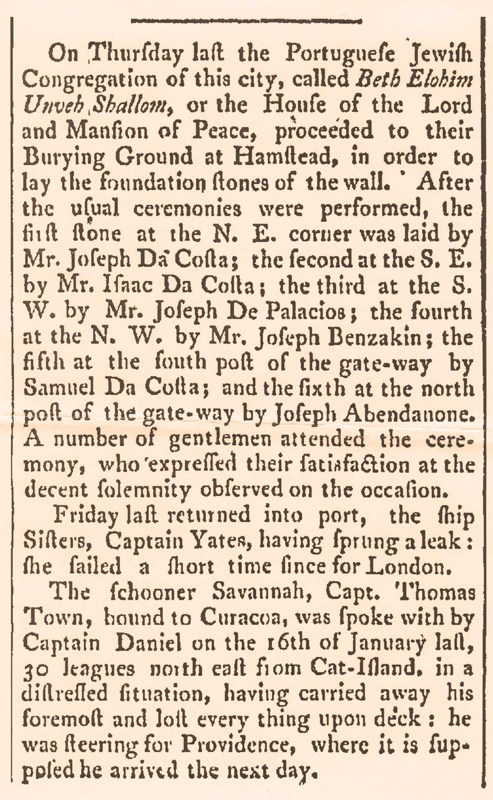Isaac DaCosta
Patriot and religious leader, benefactor of two conflicting congregations
Note that this point is off the historical map, as cemeteries were typically placed at removed locations. Charleston grew to encompass this early cemetery over the next century.
An immigrant from London, Isaac DaCosta (1721–1783) was among the organizers of Charleston’s congregation Kahal Kadosh Beth Elohim in 1749, and was elected the synagogue’s first hazan, a cantor or prayer leader in a synagogue. During the eighteenth and nineteenth centuries, when there were few ordained rabbis in the United States, congregations often were led by hazanim, who were commonly referred to as “Reverend.”
He also gave the congregation its first graveyard. Records of DaCosta’s earliest business dealings have not been found, but by 1754 he was financially secure enough to purchase a plot of land on Coming Street to use as burial ground for his family. In 1758, he entered a partnership with Thomas Farr, Jr., a member of the Episcopal Church and a Mason, to export rice, indigo, turpentine, deer skins, and other products, and to import general merchandise such as rum, flour, beer, cider, fabrics, dry goods, and iron. With trading partners in Rhode Island, Britain, and the West Indies, DaCosta and Farr owned their own ship, a 45-ton sloop named the Carolina Packet. Between 1760 and 1763, the firm invested in at least two shipments of slaves from West Africa, and in 1765, DaCosta, on his own, imported another shipload of African captives.
Isaac DaCosta’s brother, Abraham DaCosta (d. 1786), served KKBE as hazan from circa 1762 to 1764. In the latter year, Isaac transferred ownership of his family burial ground on Coming Street to the congregation “for the use of those who observed the regulations of Beth Elohim.” In the same year, however, a dispute within the congregation led to Abraham’s resignation as hazan. A decade later, the DaCostas again found themselves at odds with other members, this time owing to tensions between the longstanding congregants, who were mostly of Sephardic ancestry, and the growing number of Ashkenazim, newcomers from German-speaking states or Eastern Europe. The split resulted in the establishment of a separate synagogue, Unveh Sholom, which was active on Beresford (Fulton) Street by 1783, and might have been founded before the Revolution.
Isaac DaCosta and several other Jews were among dozens of Charlestonians banished from the city from 1780 to 1782 during the British occupation. Along with Declaration of Independence signers Thomas Heyward, Jr., and Edward Rutledge, as well as patriot Christopher Gadsden, DaCosta took refuge in Philadelphia with his wife, Sarah, and their two children. He died in 1783, after the family’s return to Charleston, and was buried, not in the cemetery on Coming Street that he had conveyed to KKBE, but in a separate plot, here, on Hanover Street. This burying ground, first known as DaCosta Cemetery, became the property of the Sephardic Unveh Sholom congregation, but eventually was deeded to KKBE.
Isaac DaCosta was the first Jew known to have joined a Masonic lodge in Charleston. He became a member of Solomon’s Lodge No.1 in 1753, and six years later was elected its treasurer. After the Revolution, he helped organize the Sublime Grand Lodge of Perfection, which, in 1801, became the Supreme Council of the Ancient and Accepted Scottish Rite.
